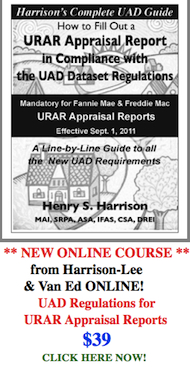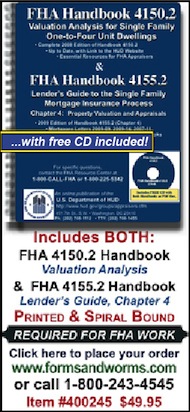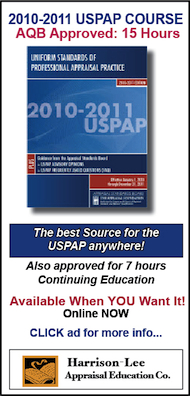Ask Henry
Dear H2,
Is it acceptable to complete a URAR form 1004 "As-is" and also give a cost to cure? I appraised a house that had water stains on the ceilings and walls due to a prior roof leak which has been repaired. I gave a cost to cure of $8,000 to replace the damaged drywall and have the walls and ceiling repaired and replastered. But I did not call for this to be a condition of the appraisal; it was merely a "heads up" to the lender that there were water stains, etc. My exact wording was as follows:
"The subject property was in good exterior physical condition; the subject's roof is 5 years old and had leaked onto some of the interior 2nd floor walls prior to replacement according to family members of the owner. As a result the interior walls show signs of old water staining, peeling paint, and cracks in plaster (see photos). This is seen as cosmetic deferred maintenance in nature; repair is not called for, but the cost to cure is estimated at $8,000."
Is this proper or is it a conflict of statements?
Thanks,
Al Benjamin
albenj401@verizon.net
Dear Al,
As long as your appraisal is clearly the value of the property in "as is" condition, there should be no problem. The problem occurs when it is implied in the wording somewhere that the value of the property when cured is the "as is" value plus the cost to cure. The cost to cure and the increased value of what is "cured" are not directly related. The market may recognize only a fraction of the cost to cure in a subsequent purchase -- or none at all.
Sound Off!!
Dear Henry:
I am not a real estate professional, but a homeowner. Recently, I witnessed a spasm of over-appraisal of real estate, caused by appraiser eagerness to please the banks during the real estate bubble, followed by what the newspapers have proclaimed as a "correction," in the post-bubble-pop period.
I now have reason to doubt that any such "correction" actually has occurred. A real correction of this spasm of over-appraisal of real estate, would have required the appraiser to transit from dishonesty toward honesty. Instead, in my personal evaluation, based upon what I have personally witnessed, what has occurred is that the appraiser has transited directly from dishonesty-one-way to dishonesty-the-opposite-way. What has happened is that the appraiser, who had been overeager to suck up to the bank by over-appraisal, has become overeager to suck up to the bank by under-appraisal. That's equally dishonest, and not something to be proud of.
It has been proclaimed, in the newspapers, that in order to correct the previous tainted situation, the banks have distanced themselves from the appraisal industry. Now, supposedly, that problem has been coped with, because banks no longer have direct contact with the appraiser who is chosen.
However, in my view, the only thing that has changed is the banks have changed the sort of dishonesty they require now to under-estimate dishonesty. From my perspective, this creates a very negative attitude toward your profession.
Austin Meredith
Durham, NC
kouroo@kouroo.info
Dear Austin,
Appraiser independence is a problem that has plagued the appraisal profession for as long as I can remember.
(I became an appraiser in the 1960s).
The largest national appraisal organization gave appraisers designations in recognition of their education and experience, the MAI -- which soon became called by some "Made As Instructed".
The profession continuously lobbies for legislation that prohibits trying to influence the outcome of an appraisal to stop the problem. In my opinion, based on human nature, the problem is always going to exist. Appraisers are human beings, and their well-being depends upon satisfying their customers.
I don't think they are different from other professionals who also try to satisfy the patients, clients and bosses.
Ask Henry
Hi H2:
Still a fan of your column/blog after all these years!
My question is: how do we adjust for bank sales and short sales when the only comparables available are in these two categories? In the past, we were able to find similar comps that were not REOs or short sales -- but that has now become impossible in some areas where I practice.
Larry Kowitt
Real Estate Appraiser, New Jersey
KowittL@aol.com
Dear Larry,
This depends upon what is happening in the subject property's market area for houses similar to the subject property. If the market area is flooded with short sales and bank sales, a prudent buyer is not going to buy the subject house unless it is priced competitively with those sales. Therefore, you should be using bank sales (REOs) and short sales as comparables and an adjustment may not be needed. It is more complicated when bank sales and short sales make up only a portion of the market. A prudent buyer would try to buy an REO or short sale if they were available on the effective date of the appraisal. Therefore, you would have to consider competitive listings. Ask yourself this question: "If the subject property were not available for sale on the effective date of the appraisal, what would a potential buyer of that property accept from what is available?" What they would buy as a substitute basically defines the comparables, and determines the value of the subject property.
News
Use of Distress Sales in Real Property Market Value Appraisals
Question:
A client has asked me to disregard any foreclosure, real estate owned (REO), or short sales when performing market value appraisal assignments. Is this an acceptable assignment condition?
Response:
No. USPAP does not specifically address which sales should or should not be considered in an appraisal assignment. However, in real property appraisal assignments, Standards Rule 1-4(a) requires: When a sales comparison approach is necessary for credible results, an appraiser must analyze such comparable sales data as are available to indicate a value conclusion. (emphasis added)
So, the appraiser must determine what data is relevant. There are many appraisal assignments where, in order to achieve credible results, it is necessary to use “distress” (e.g., REO or Short Sales) properties as comparable sales. However, foreclosure sales, defined by Black’s Law Dictionary as “the sale of mortgaged property, authorized by a court decree or a power-of-sale clause, to satisfy the debt” are seldom based on market expectations. When there is a glut of distress sales in the marketplace, and those properties are truly comparable to the subject, it would be misleading not to use them as part (or in some cases all) of the basis for a value conclusion. A client-imposed requirement to disregard data that may be relevant and necessary for credible assignment results would be an unacceptable assignment condition. (emphasis added)
To download the entire PDF, click here: USPAP Q & A
Article
According to an article published by Property Casualty 360, the Government Accountability Office has issued a scathing report on the management of the National Flood Insurance Program (NFIP). "There is no way the program will ever be “financially sound”, according to GAO. The report warns that unless FEMA - the Federal Emergency Management Agency, which administers the program, cleans up its act, it will be limited in its ability to manage NFIP’s operations or better ensure program effectiveness.
The report was issued in conjunction with a Senate Banking Committee hearing on the NFIP. The GAO report says that "the pressure on the NFIP to provide services for everyone limits FEMA’s ability to keep the program financially sound." Under present circumstances, “NFIP’s long-term financial solvency will remain in doubt.” The report points out weaknesses in the NFIP’s insurance policy and claims management systems, noting that FEMA cancelled a modernization initiative called “NextGen” in November 2009 -- because the system failed to meet “user expectations" despite seven years of effort and the expenditure of $40 million dollars! (emphasis added)
FEMA "faces significant management challenges in areas that affect the NFIP, including strategic and human capital planning; collaboration among offices; and records, financial, and acquisition management. FEMA has not developed goals, objectives, or performance measures for the NFIP, and that the program faces high turnover and weaknesses in the oversight of its many contractors." Furthermore, “FEMA needs a plan that would ensure consistent day-to-day operations when it deploys staff to federal disasters.”
FEMA lacks a comprehensive set of processes and systems to guide its operations, in particular "a records-management policy and an electronic document management system.” While FEMA has begun to address some of these challenges, including acquisition management, “...unless it takes further steps to address these management challenges, FEMA will be limited in its ability to manage NFIP’s operations or better ensure program effectiveness."
Ask Henry
Customary & Reasonable Fees in Certification
Dear H2:
This is a portion of a six page contract that I have to sign and send back in order to receive additional work with NREIS, address below. They are well known to pay low fees, and to take 90 or more days to pay the appraiser. Here's what the contract states about fees:
- - - - - - - - - - - - - - - - - - - - - - - - - - - - - - - - - - - - - - - -
National Real Estate Information Services, a Pennsylvania limited partnership, having an address at 100 Beecham Drive, Pittsburgh, PA 15205 (the “Company”). The following certification should appear in the additional comments section of page 3 of the appraisal form:
“I have agreed to the terms of payment from Company and consider the fee to be customary and reasonable for my specific market for this specific property and report type.” (Emphasis added.)
"No employee, director, officer, or agent of the lender, or any other third party acting as a joint venture partner, independent contractor, appraisal management company, or partner on behalf of the lender has influenced or attempted to influence the development, reporting, result, or review of this assignment through coercion, extortion, collusion, compensation, instruction, inducement, intimidation, bribery or in any other manner.”
“I have not been contacted by anyone other than the intended user (lender/client as identified on the first page of the report), borrower, or designated contact to make an appointment to enter the property.”
“I have agreed to immediately report any unauthorized contacts either personally by phone or electronically to Company."
“I understand that according to the current regulations, that it is mandatory for the client or intended user of this report to inform the proper regulatory agency if this report does not comply with USPAP Standards.”
The above certification is to be included within the actual appraisal on every report you complete for COMPANY.
- - - - - - - - - - - - - - - - - - - - - - - - - - - - - - - - - - - - - - - -
I hope that we can fight this current interpretation of “customary and reasonable” fees, as several other AMCs are using the same rationale. If we sign such a contract, we basically agree with their concept of what we should be paid! How is that "independent fee appraising"?
Bob Godwin
Appraisal Services of the Gulf Coast
Pensacola, FL
rcgodwin2@appraise.gccoxmail.com
Dear Bob,
I have some doubts in my mind as to whether this is an appropriate thing to be part of an appraisal report, especially where they want you to put it on page three. However, I am not aware of any regulation that prevents you from doing so as long as what it say is correct. I think you have to make a business decision as to how badly you want their work.
Sound Off!
Dear Henry,
If a floundering submarine has sunk and is now taking on water, why in the "h***" would anyone stay on board? Gee, that sounds like Fannie/Freddie......morally, ethically, financially — and now intellectually — bankrupt. Why would anyone listen to their 'guidelines' and/or the 'new' UAD? I know that I am not writing this as a lone wolf, as over 51% of the appraisers would rather be pursuing some other career at this point. Oh, I almost forgot to mention that Fannie is trading 'OTC' at .39 cents a share! Wow — how the mighty have fallen from a high of around $65.00 a share!! I sure am glad that I told our investment club not to invest in Fannie 6 years ago. I could smell it coming. Apple Computer has done better with a pay-off well in the 5 figures as an investment.
I see Fannie/Freddie as just another failed institution. So: UAD — why, and who cares? Like a loan officer once told me, "You know, Don, the more paper work that is required by Fannie/Freddie, the better the loan..." (Of course, he was kidding!)
Seems the powers that be are determined to take the 'art' out of appraising. That's something to think about.
Donald Lentz
alliedappraisal@epix.net
Dear Donald,
I am sure many appraisers would agree with your desire that Fannie Mae and Freddie Mac disappear. Buying their stock now is like buying a lottery ticket. In my opinion, they may change their names and they may become government agencies again, but they are not going to go away. Freddie and Fannie play a key role in the mortgage market that may be impossible to replace, at least in the short term. I agree that it is unlikely the UAD will make much difference in the quality of appraisals. This is not its primary purpose, which is to standardize the way appraisals are electronically transmitted. However, after studying the UAD for over three months in preparation for writing the UAD/URAR guide, I don't think there is anything in the UAD that prevents an appraiser from producing a quality appraisal and complying with the USPAP.
The computer, unfortunately, has contributed to removing the "art" from appraising. I agree with you that appraising is not a science, and that making good appraisals is really an art.
HSH
askhenryharrison@revmag.com
Editorial
Two important letters have been written to the General Counsel of the Federal Housing Finance Agency (FHFA) which is the government agency current in charge of Fannie Mae and Freddie Mac because of their dire financial condition. Both of these letters are critical of the UAD and its proposed implementation. One letter is from Ami Mine-Allen, President of the Association of Appraisal Regulatory Officials (AARO). The other is from J. Carl Schultz, Chair of the Appraisal Standards Board (ASB) of the Appraisal Foundation.
It always surprises me how many appraisers are confused about the functions of the Appraisal Foundation, the State Real Estate Appraisal Commissions and their regulatory officials. The Appraisal Foundations creates the standards (USPAP), but has no authority or mechanism to enforce them. The individual state Real Estate Appraisal Commissions and their regulatory officials grant licenses and certifications, and are in charge of enforcing the USPAP along with their "state specific" regulations. Read More...





















